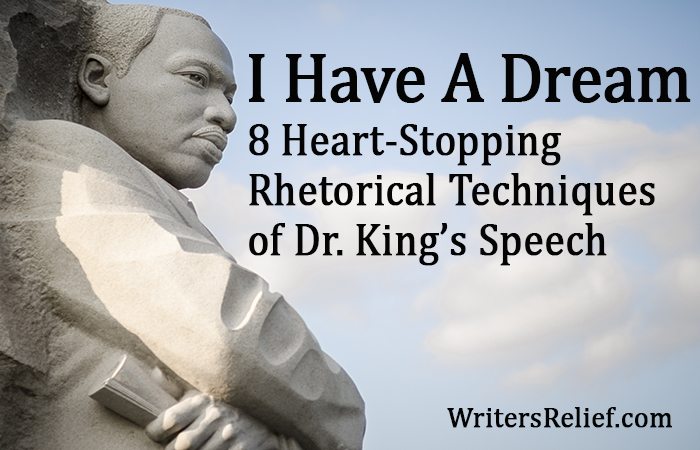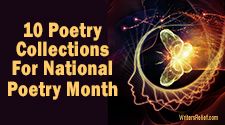
Martin Luther King, Jr.’s “I Have A Dream” speech was a life-affirming call to all people to live together in love. But it was something else too: a literary masterpiece. King taught us a lot about peace and understanding, but we at Writer’s Relief believe he also has a lot to teach writers about rhetoric.
Studying King’s rhetorical techniques is a great way to shore up your craft, leading to more memorable poems or characters.
Rhetorical Techniques Of Martin Luther King’s “I Have A Dream” Speech
Alliteration. King’s phenomenal ear for the music of language is legendary—and we hear the lyricism of his prose in his alliterations.
Example: Rise from the dark and desolate…the marvelous new militancy…trials and tribulations…
Allusion. King’s speech reaches well beyond his words. He points to shared references that are already heavily loaded with built-in emotion.
Example: Five score years ago, a great American…signed the Emancipation Proclamation.
Example: Many references and quotes from “My Country, ‘Tis of Thee” and “Free at Last.”
Amplification. This happens when a writer makes a point twice in a row, with greater emphasis, details, or explanation the second time—thus, amplifying it. It’s powerfully effective.
Example: America has given the Negro people a bad check, a check which has come back marked “insufficient funds.”
Antithesis. This is a contrast made clear by using contrasting language. In the following, King places color/content and skin/character side by side, drawing our attention to radically different ways of seeing the world.
Example: I have a dream that my four little children will one day live in a nation where they will not be judged by the color of their skin but by the content of their character.
Conduplicatio. This is the repetition of a word or phrase, often at the beginning of a series of sentences or phrases.
Example: Repetition of sentences beginning with “I have a dream.”
Litotes. You may be using litotes without even knowing it. By using understatement, along with a double negative, King draws our attention in.
Example: I am not unmindful that some of you have come here out of great trials and tribulations.
Metaphor. We’re not talking about “the cloud was a ball of cotton candy.” We’re talking hard-hitting metaphors that aren’t just about making comparisons but about stirring emotions.
Example: [The Emancipation Proclamation] came as a joyous daybreak to end the long night of their captivity.
Example: We will be able to hew out of the mountain of despair a stone of hope.
Parallelism. With parallel phrasing, King carries his message with engaging, memorable rhythm. Isn’t it gorgeous how the passage below builds?
Example: We will be able to work together, to pray together, to struggle together, to go to jail together, to stand up for freedom together…
One More Thing We Learn About Rhetoric From Martin Luther King, Jr.
While we’ve taken a moment to dissect some of King’s rhetorical techniques, there’s one key thing that makes this speech such a standout: heart. Separating King’s talent as a writer from his passion for his cause is impossible; the success of this particular speech comes from the combination of passionate caring AND eloquence.
While we cannot expect anyone to come close to what Dr. King was able to achieve, take a moment to learn from his rhetorical techniques. Once you’ve polished your writing, Writer’s Relief can help you pinpoint the best literary agents or journals for your work. Learn more about our services and submit your work to our Review Board today!
Whether you want to take the traditional publishing route or prefer to self-publish, we can help. Give us a call, and we will point you in the right direction!

 QUESTION: What is the rhetorical technique you use most often in your writing?
QUESTION: What is the rhetorical technique you use most often in your writing?



















Great speech always and thanks for highlighting those eight. If however i were to edit that speech today, “trials and tribulations” will be expunged for being cliched. See how the times change!
thanks for this.. it will help me a lot.
thanks for this, really helped..
Thanks heaps…very helpful! thanks again!
Thanks for sharing Dr. King’s speech as part of writing effective and
creative words. He was an intelligence human-being and brought
great clarity into this world with his thoughts and beliefs. His
writing proved to be professional and well-polished. He was an eloquent speaker. This was a great man who helped changed the world for the better not only in his writing but his disciplinary ways and thought pattern. I learned a lots from this article.
free at last free at last, thank god almighty free at last
Thanks, really helped me with my homework! 🙂
Am kenyan, living in kenya, staying hopeful in kenya and dreaming in Kenya. this speech lingers in my mind when i think of the poverty eating up the country’s stability. it is not just a speech but a prayer as well
Thanks. This is a big help for annotating this great speech. I get goosebumps every time i hear it.
Thanks,to this speech i’ve got my home work right
What are some more examples of parallelism
Bessie, we found thisthat might help you.
thnx .it really help me with my home work
thanks great help
Very helpful! Could you do more of the speech?!
Thank you for your comment! We will certainly consider it.
I have speech techniques
maybe it might help you guys
when you are reading a speech to a crowd or to your class, the best techniques are to:
1. be confident
2. use persuasive words
3. use a lot of rhetoric
4. don’t move your legs or swing your arms
5. when reading your speech don’t say ‘umm’
6. if you get a little shy then look at something and don’t stop looking at it. this actually works
thank you for reading
I need specific strategies.
Hello Daysie,
Please browse the Writer’s Relief website for informative and informational articles regarding writing techniques and strategies.
Thank you.
I found this speech was very powerful, encouraging and helpful. I didn’t really understand anything about rhetorical techniques, but after reading this article and the breakdown of techniques I have a better understanding. It definitely helped me to understand which technique I generally use.
Thank you for teaching me about Rhetorical Techniques. This was an excellent choice that captured my attention “I Have A Dream” Speech by Dr. Martin Luther King.
this helped with a short essay. I also just wanted to comment because im the first comment in more than 4 years. 🙂
Thanks, Vinny! Make sure to cite us properly.
I’ve taught English from elementary through college, keying I on writing. This article is invaluable. I’m retired, getting old (ummm), but I’ll never outgrow good human advice. At 76, I’m still going to find ways to use this. For example, World Day of Prayer March, 2024 is based on “I beg you, bear one another in love…” which captures MLK’s passion and humanity.
Thank you, Denna!